Token Terminal: In-depth analysis of the economic models and operational principles of L1 and L2
Author: Tokenterminal
Compiler: Shenchao TechFlow
We often intuitively feel the costs and benefits generated by using different blockchains, namely gas fees and incentives.
However, do you really understand their complete economic models? Where do gas and incentives come from, and where do they flow? How do market performances vary under different economic model designs?
Token Terminal explores the blockchain economic models of major L1 and L2 based on PoW and PoS, as well as emerging models like liquid staking. Each blockchain's economic model principles are broken down and exemplified in a very easy-to-understand manner.
At the same time, by visualizing the daily fee changes of blockchains, insights into the market performances of mainstream blockchains are provided, allowing investors to use the framework in the text to compare the economic performance, potential, and sustainability of different blockchains.
Introduction
The following chart visualizes the daily fees of the blockchains mentioned in this article over the past 180 days.
Senchao Note: It can be seen that Ethereum and Bitcoin still lead significantly in total transaction fees.
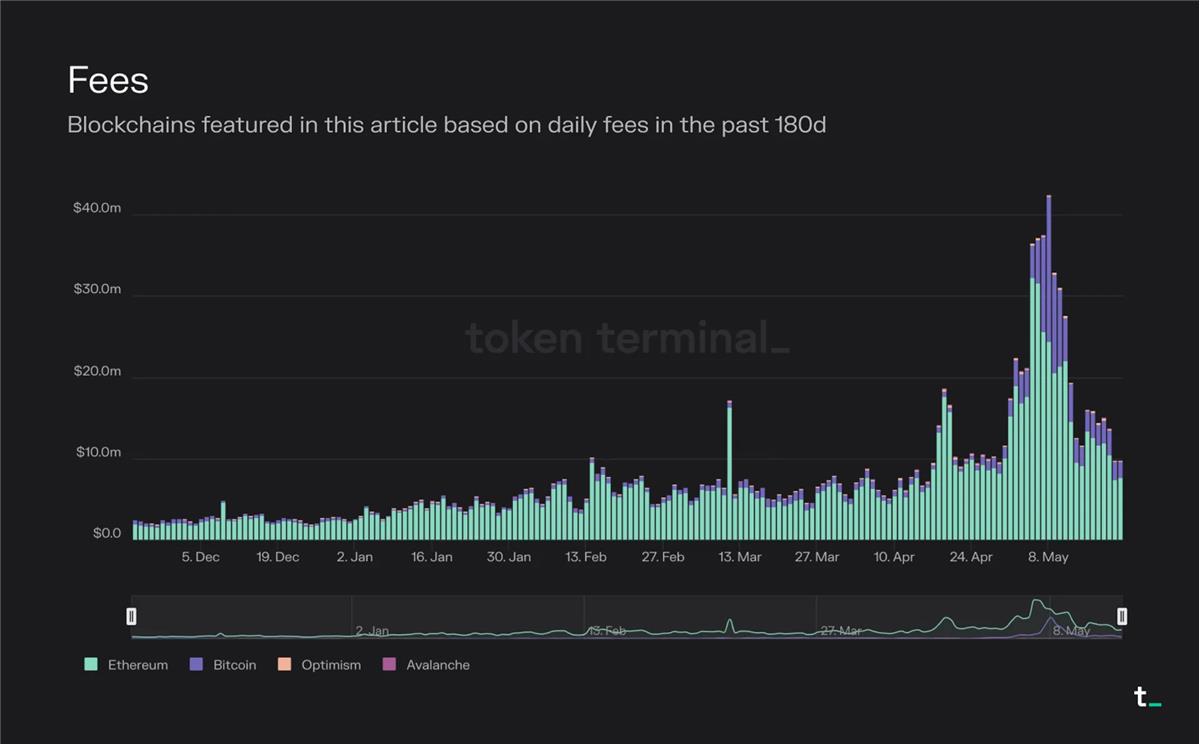
The key components that typically constitute the economic structure of a blockchain are transaction fees, inflationary block rewards (incentives), and fee destruction.
Transaction fees represent the market price of block space.
Incentives are economic rewards that encourage people to take action (e.g., validating transactions).
Fee destruction is a mechanism that removes a portion of each transaction fee from circulation.
Given the limited capacity of individual blockchains, we will see a world with multiple different blockchains—each optimized for different use cases—interoperating with each other. The blockchain market was initially dominated by Bitcoin, which has an extremely simple and limited contract execution environment. With the launch of Ethereum, it became theoretically possible to deploy arbitrarily complex contracts or programs on the blockchain. Now, with the rise of scaling solutions, application-specific blockchains, and cross-chain bridges, it is also practically possible to deploy arbitrarily complex contracts (scalability is no longer a limitation). In this article, we will break down the economic models of the most common types of blockchains.
PoW-based L1
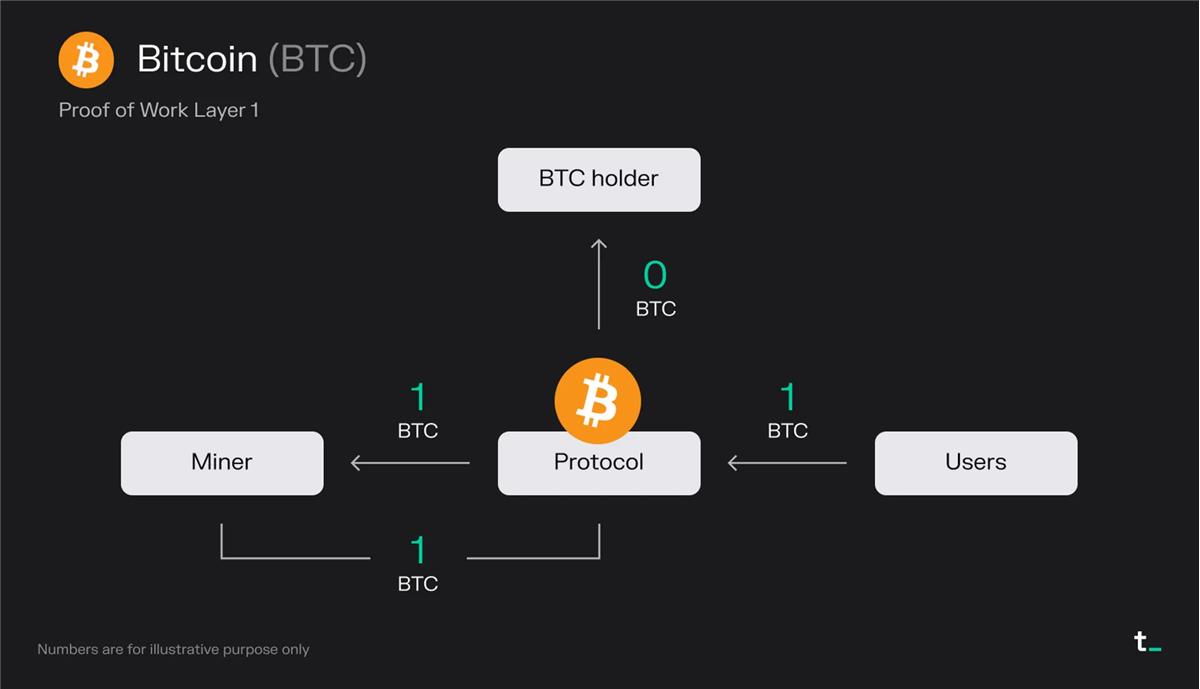
Principle Explanation:
- A user pays a transaction fee of 1 BTC for a block.
- The miner receives all fees (1 BTC).
- The miner earns 1 BTC from the block reward (newly issued BTC).
Final Result:
- The miner receives 2 BTC.
Key Points:
- The demand for submitting transactions on Bitcoin creates a market for block space. Users pay miners for block space. Block subsidies further incentivize miners; block subsidies are newly minted bitcoins that increase the total supply of the currency. Currently, all fees and block subsidies in Bitcoin go to miners.
- Bitcoin provides security through CPU power. The value proposition of Bitcoin is to create a secure, transparent, and immutable global ledger that allows for trustless and irreversible value transfer. This value is maintained by security derived from CPU usage. Each block requires a significant amount of CPU power to be validated on the network. Essentially, 1 CPU corresponds to 1 vote on the network. Therefore, as long as the majority of CPU power is held by honest miners, the network is secure.
- The economics of Bitcoin are determined by two variables: transaction fees and block subsidies. Transaction fees are determined by the supply and demand for network block space. Block subsidies are inflationary rewards that increase the circulating supply of BTC. Currently, a miner receives a reward of 6.25 bitcoins per block, which is halved every four years. Ultimately, Bitcoin will reach a maximum supply of 21 million (expected to occur around 2140), and block rewards will consist solely of transaction fees. This means user adoption is crucial for maintaining the economic sustainability of the network.
PoS-based L1
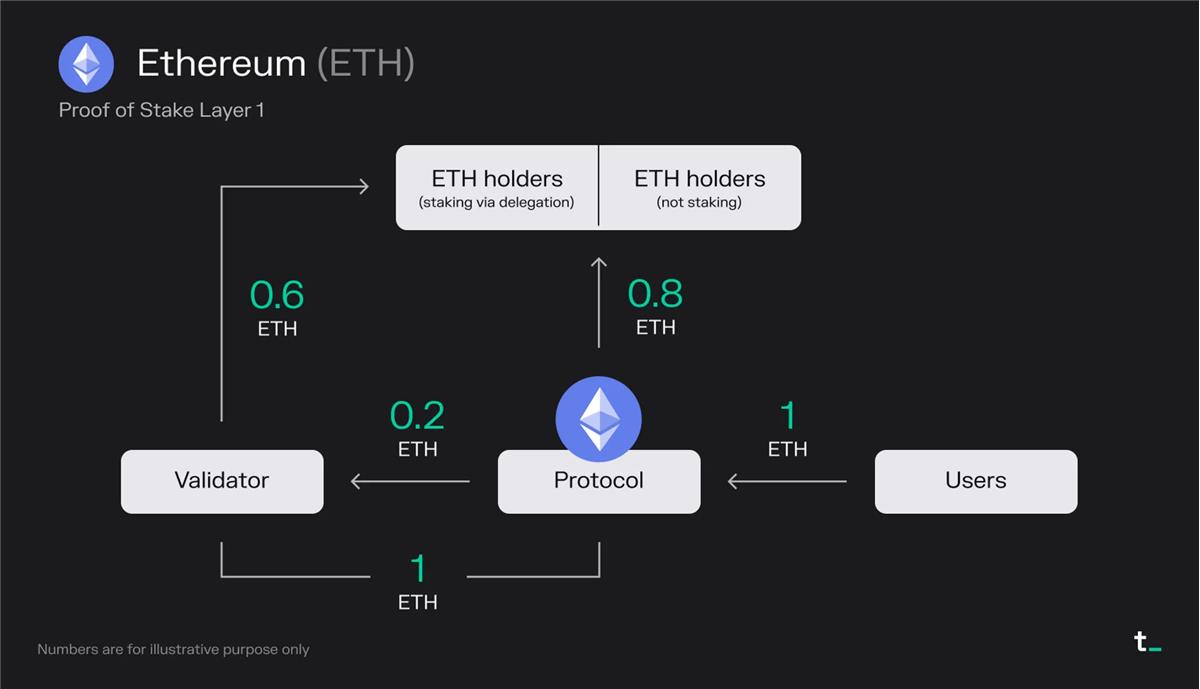
Principle Explanation:
- A user pays a transaction fee of 1 ETH for a block (including MEV).
- 0.8 ETH is destroyed ---> "stock buyback" benefits all ETH holders equally.
- The validator earns 0.2 ETH from the fees.
- The validator receives 1 ETH from the block reward (newly issued ETH).
- Since the validator has already obtained half of the shares from delegators, the validator must share 50% of its earnings with these ETH holders.
Final Result:
- 0.8 ETH is destroyed.
- The validator receives 0.6 ETH.
- ETH holders who delegated staking receive 0.6 ETH.
Key Points:
- On Ethereum, about 85% of total transaction fees are destroyed, effectively acting as a "stock buyback," benefiting all ETH holders equally. Meanwhile, validators earn the remaining fees and additional staking rewards, which are newly minted ETH. Over the past 30 days, Ethereum has averaged about $15 million in daily fees.
- The fee-burning mechanism implemented through EIP-1559 in August 2021 turned ETH into a productive asset. Additionally, the transition from PoW to PoS reduced the new issuance rate of ETH. Since the Merge in September 2022, Ethereum no longer distributes block rewards to miners. This change has led to a decrease in the issuance of new ETH by about 90% (approximately 14k ETH/day in block rewards replaced by about 1.7k ETH/day in staking rewards). This has resulted in a deflationary supply of ETH during periods of high usage.
- The economic structure of Ethereum consists of three key components: total transaction fees, the portion of transaction fees that is destroyed, and staking rewards. Transaction fees are determined by the supply and demand for network block space. Staking rewards are inflationary rewards that increase the total supply of ETH. The burning of transaction fees creates deflationary pressure on ETH, while the reduction in circulating supply may increase the value of the token over time.
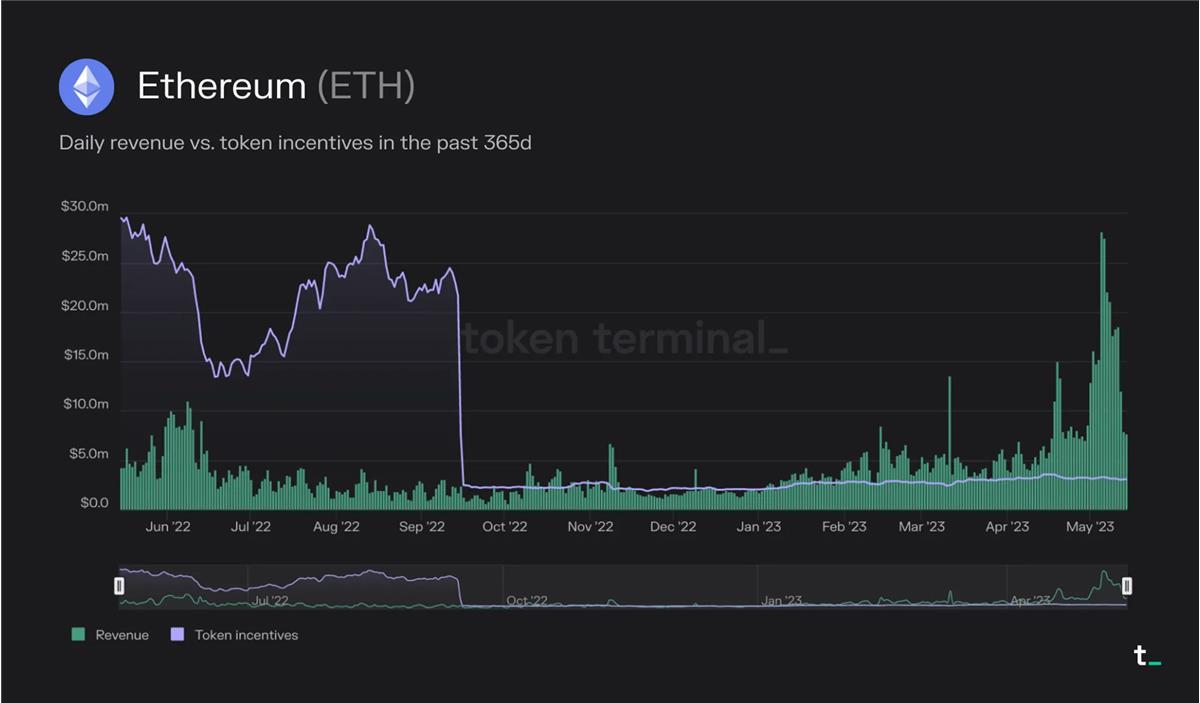
After the Merge, the supply of ETH has remained deflationary during periods of high usage. For example, in May of this year, the amount of ETH destroyed (revenue) has consistently exceeded the amount of ETH minted as staking rewards (token incentives).
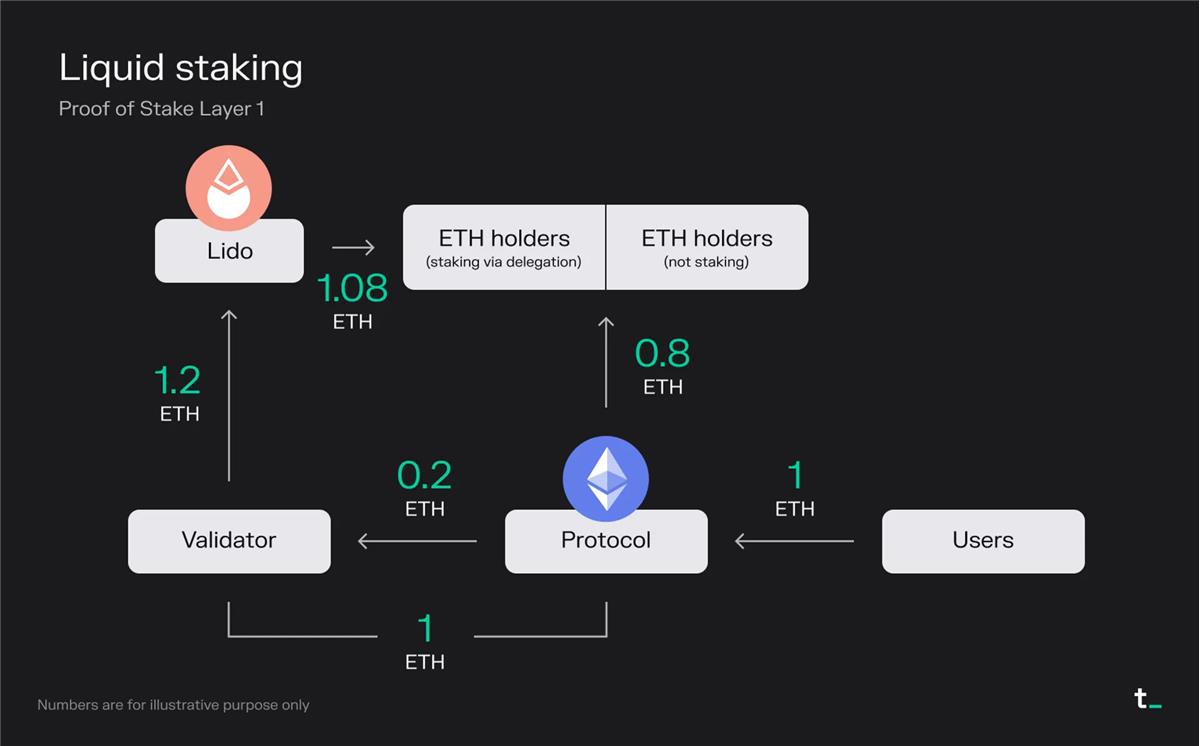
Liquid staking projects allow users to stake their assets while maintaining liquidity through derivative liquidity tokens (liquid staking derivatives, LSD) that represent the underlying asset.
Principle Explanation:
- A user pays a transaction fee of 1 ETH for a block (including MEV).
- 0.8 ETH is destroyed ---> "stock buyback" benefits all ETH holders equally.
- The validator earns 0.2 ETH from the fees.
- The validator receives 1 ETH from the block reward (newly issued ETH).
- The validator has obtained all shares from users who deposited ETH through the liquidity staking protocol Lido, so it shares 100% of its earnings with these ETH holders.
- Lido takes a 10% cut (0.12 ETH) from the total staking rewards for providing the service and distributes the remaining 90% (1.08 ETH) to ETH holders who staked through Lido.
Final Result:
- 0.8 ETH is destroyed.
- The validator receives 0 ETH.
- Lido receives 0.12 ETH (of which 50% is used to cover node operation costs).
- ETH holders who delegated staking will receive 1.08 ETH.
Key Points:
- Liquid staking protocols enhance user experience. Staking, which is inherently a technical and high-maintenance process, has been simplified by protocols like Lido. By allowing users to lock their ETH and receive transferable utility tokens (stETH), Lido facilitates seamless staking while enabling users to earn rewards associated with validation activities. To provide this service, Lido takes a 10% fee from the total earnings. This fee is split between node operators and Lido DAO.
- The technical and high capital requirements of staking have opened opportunities for liquid staking protocols. Traditional Ethereum staking requires users to maintain a node, invest a significant amount of capital (32 ETH), and sacrifice token liquidity. In contrast, Lido batches users' tokens and allocates them to validators, eliminating the 32 ETH barrier. By simplifying the user experience, providing liquidity, and democratizing staking, Lido and similar protocols are opening a rapidly growing market segment.
- The democratization of staking allows broader investor participation. Besides blockchain (L2), the liquid staking market segment is one of the fastest-growing market segments. The successful execution of the Shapella upgrade (April 12) arguably reduced the risks associated with ETH as an investment and the risks associated with ETH as a yield-bearing asset. Therefore, the ETH staking ratio (staked assets/circulating market cap) is expected to grow and align with other PoS chains. Currently, the staking ratio of ETH is about 15%, which is relatively low compared to other PoS chains. For example, Solana and Avalanche currently have over 60% staking rates. Given ETH's high market cap, approximately $220 billion at the time of writing, we can expect staked assets to grow by billions of dollars in the coming quarters.
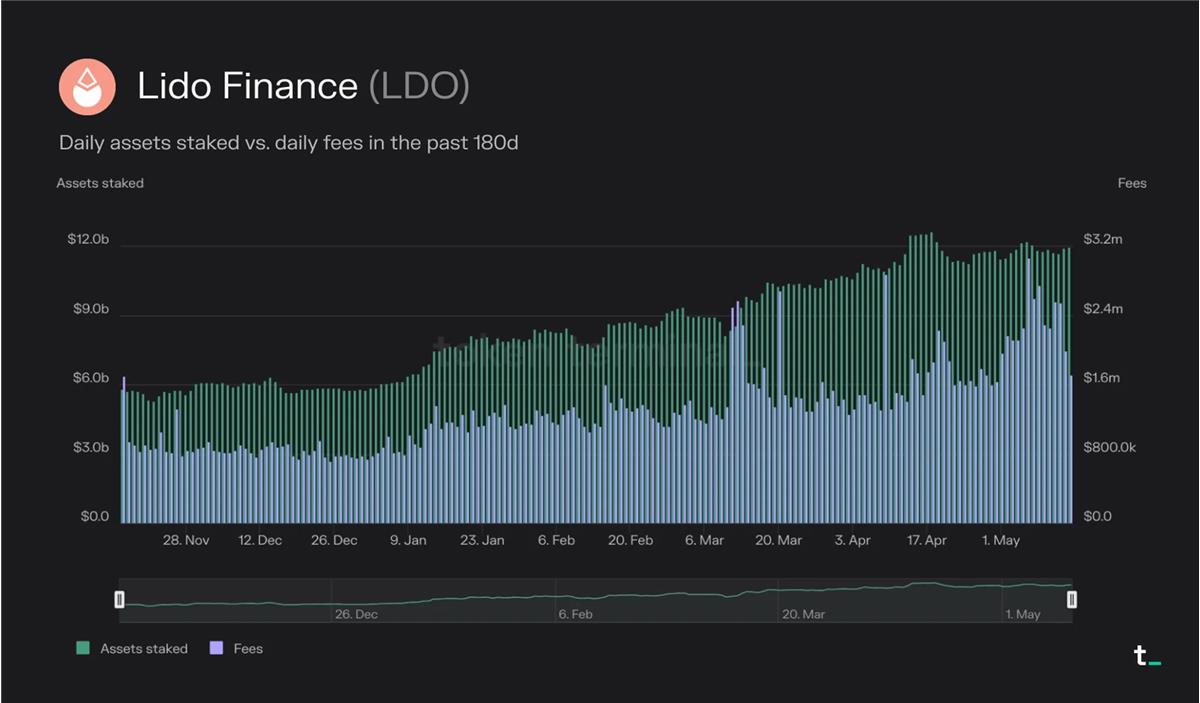
Lido has become the current market leader in the liquid staking market, with a total staked asset of $12 billion. This figure has increased by 38% year-on-year and has grown by 105% over the past 180 days.
In the past 30 days, Lido generated $60.4 million in fees and received 10% of that, or $6.04 million in revenue. This revenue is distributed 50/50 between node operators and Lido DAO.
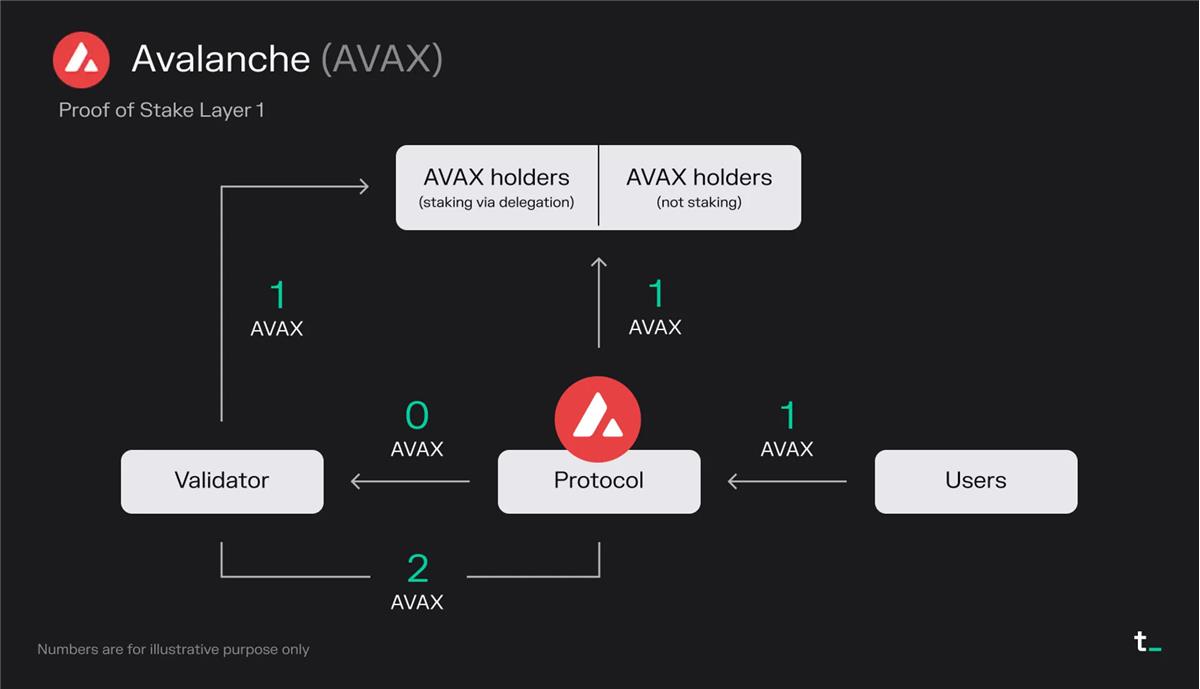
Avalanche is a blockchain (L1) that competes with Ethereum by prioritizing scalability and faster transaction speeds. It uses a novel consensus algorithm that provides strong security, rapid transaction finality, and high throughput while maintaining decentralization.
Principle Explanation:
- A user pays a transaction fee of 1 AVAX for a block.
- 1 AVAX is destroyed ---> "stock buyback" benefits all AVAX holders equally.
- The validator earns 0 AVAX from the fees.
- The validator receives 2 AVAX from the block reward (newly issued AVAX).
- Since the validator has obtained part of the shares from delegators, the validator must share its earnings with those AVAX holders.
Final Result:
- 1 AVAX is destroyed.
- The validator receives 1 AVAX.
- AVAX holders who delegated staking will receive 1 AVAX.
Key Points:
- On Avalanche, all transaction fees are destroyed, and the only source of income for validators is staking rewards. The destruction mechanism acts as a "stock buyback," benefiting all AVAX holders equally. Over the past 30 days, Avalanche has averaged about $64,000 in daily fees.
- As a relatively new member of the blockchain space, Avalanche is issuing a large number of AVAX tokens to reward its validators. This approach is often used as a way to drive growth in the early stages of a platform. These rewards attract validators and stimulate growth and activity within the Avalanche ecosystem.
- The economic model of Avalanche may change in the future. The fee and reward structure is not set in stone and can be adjusted based on future governance decisions. Currently, 50% of the total supply of AVAX tokens is allocated as staking rewards for validators. This allocation plan occurs over ten years, from 2020 to 2030. As the distribution of staking rewards eventually ends, we may see a portion of transaction fees redirected to validators in the future.
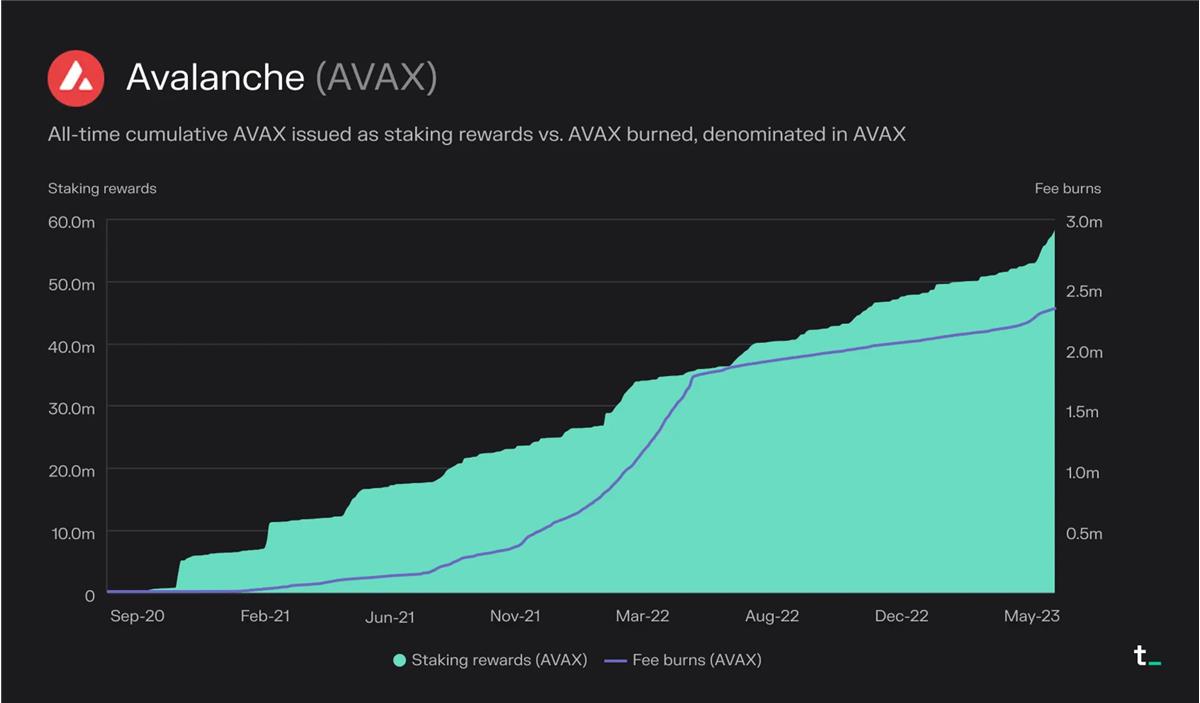
Since the network launched in September 2020, approximately 2.3 million AVAX have been destroyed, and about 57 million AVAX have been distributed as staking rewards.
PoS-based L2
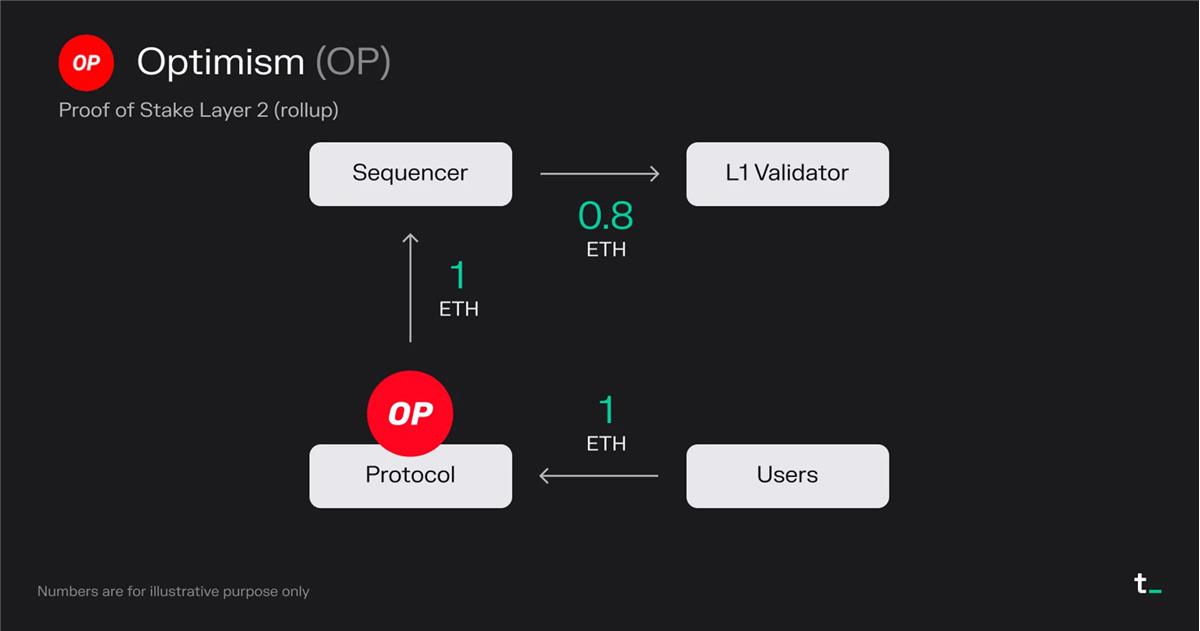
Optimism is a scaling solution (optimistic rollup) designed to improve Ethereum by increasing its transaction speed and throughput. Optimism executes transactions on L2 and submits them in batches to L1 for finalization. Depending on the type of transaction, this results in approximately 5-20 times lower gas fees.
Principle Explanation:
- A user pays a transaction fee of 1 ETH for a block.
- All transaction fees (1 ETH) go to the sequencer operated by the Optimism Foundation.
- The sequencer pays 0.8 ETH in transaction fees to submit the transaction to L1 (Ethereum).
- The sequencer (in this case, the Optimism Foundation) retains 0.2 ETH as profit.
Final Result:
- 0 ETH is destroyed (excluding destruction on Ethereum).
- The sequencer receives 0.2 ETH.
- L1 validators receive 0.8 ETH.
Key Points:
- Layer 2 blockchains expand application usage. L2 blockchains allow widely used L1 applications, such as Uniswap, Blur, OpenSea, etc., to shift their transaction activities from L1 to a separate chain that periodically settles their transactions back to L1. Currently, over 30% of Uniswap's transactions come from L2.
- Layer 2 blockchains support a more optimized user experience. As L2, the application can optimize the user experience for its use case (e.g., trading) (transaction fees/MEV collection and rebates, on-chain privacy, etc.). This optimization can be implemented while still maintaining transaction records on the more secure L1.
- The economics of Layer 2 blockchains are driven by two variables: the fees charged by L2 and the costs of settling transactions to L1. The primary business model of L2 blockchains is to generate revenue by cutting the transaction fees paid by users. Profit margins are determined by the costs of settling transactions to L1. For example, users on Optimism have paid a total of $38.2 million in transaction fees since its launch. Of these fees, $28.5 million was used to pay gas fees for submitting transactions to Ethereum. Therefore, Optimism captures the difference, which is $9.7 million, as revenue. As competition intensifies, profit margins for L2 blockchains are expected to decline. L2 blockchains that can optimize their gas expenditures on Ethereum through data compression and other technologies may further reduce L2 fees and potentially gain market share in the future.
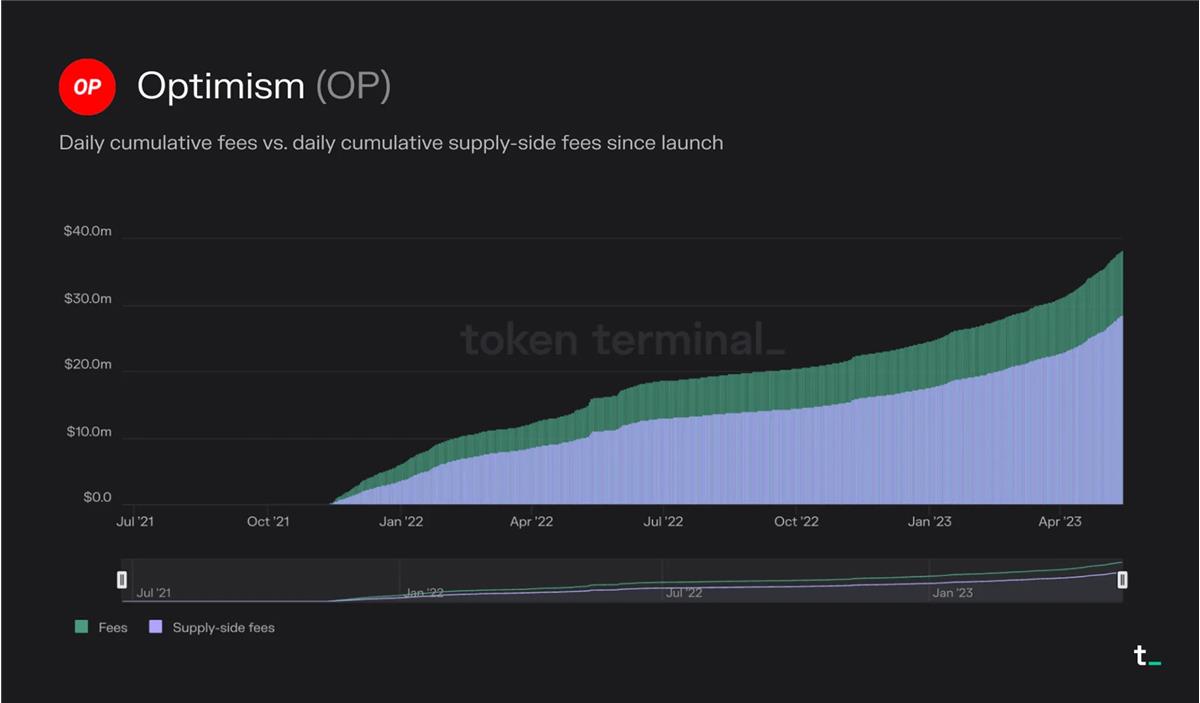
Since the network's launch, users on Optimism have paid a total of $38.2 million in transaction fees. Of these fees, $28.5 million was used to pay gas fees for submitting transactions to Ethereum.
Conclusion
Blockchains are redefining the infrastructure of economic activities by providing decentralized, secure, and transparent transaction processing architectures. In a rapidly evolving industry like crypto, we see continuous innovation in the economic models of these computational platforms. Despite the differences, investors can use the framework above to compare their economic performance, potential, and sustainability.









